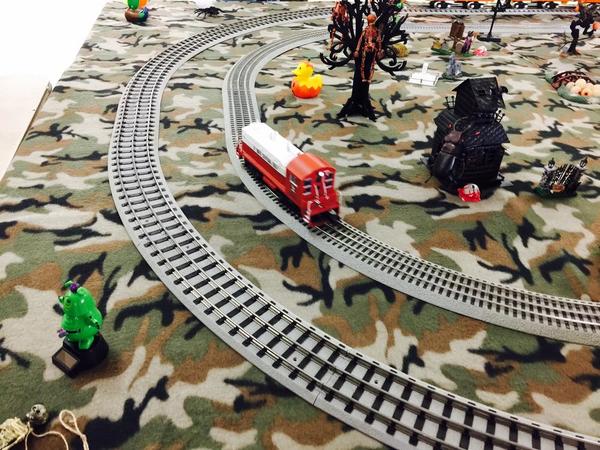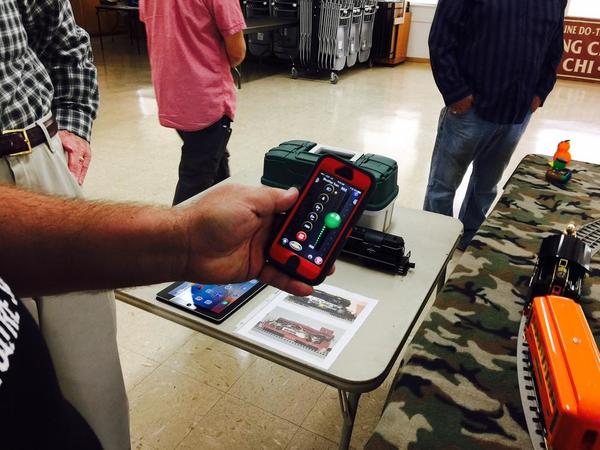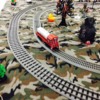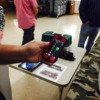"If it is too good to be true, then it probably is" The article in the most recent O guage "Bluetooth for O Gauge page 50", I find this article very exciting. If this is developed for three rail O gauge, the good by 3ed rail, track power, and a number of other things we have grown to accept. What about the shorts that close down your layout ? What about the advantages of having no power on track. Good by dirty track problems. Potentially good By big transformers. One could have charging sidings for your engines when not in use. Big question is how long can engine run just on battery power ? How do the G gauge engine do just on battery power ? Love to hear some feedback on this exciting article.
Replies sorted oldest to newest
A G gauge engine will run for 4 to 5 hours on a single full battery charge during shows on the G&O railroad. These are engines with radio control and a full sound system. The battery will last longer than the person running the train.
The key is to fully charge the battery before the show. The biggest problem we have with battery powered engines is a person bringing an uncharged engine to the show and then expecting to charge it in a few minutes. It takes several hours to fully charge a battery. I usually charge my engine overnight on the day before I plan to run it.
I think that battery power with radio control is an exciting idea. It may become the primary model engine power in the future.
NH Joe
I just read the article with interest this week. I hope this does take off for O gauge.
I just met the person who wrote the article at our TCA Western Div meet today. The battery will last about 2 hours, and takes about 3 to charge. You can run more than 2 engines at a time on the same track. He converted a Williams GP and switcher. He gave our club a demo running it from an Ipad and Iphone. The board was designed for HO, but he is developing a higher amp board for larger O scale engines/equipment.
Bob
thank you for your feedback. This could bring 2 rail O gauge back into popularity with it's added realism. I did not find the 3rd rail objectionable but a lot of railroader and modelers do. I do interactive train based displays for public museums and depots and use 2 rail for that purpose.
There are lots of little annoyances the battery can help overcome, it's a matter of preference really; lots of pros and cons in the big picture though, from convenience, right down to our environment and resources.(I'll skip that, and save the good for last, so here comes the "blast"...
A cord ensures I run a train, not ever waiting on a charger, I know that's annoying from dealing with RC in the past.... or not, because it wasn't charged. And that's super annoying when you want to have fun NOW. Tools or toys it doesn't matter, I buy just about everything I can on this basis: cords before battery.
Oh, emergency flashlights! But there are my oil and gas lamps to back those up too ![]()
So at each display, it will require attention by an employee about 3-6 times a day when new, increasing over time...? If you do go that route, try powering enough track to keep the battery at, or very near full charge all day, all night. Some insurance policies may not like overnight changing fyi. (Though every EXIT sign does it, lol)
You will still need to clean wheels and track unless you like derailing. The batteries slow it some, but dust still goes from us to the air to the rails to the wheels to the Q tip.
I don't get how a phone controller is better than any other controller, it fully escapes me, and though I think on it, it always come up a downgrade. With a separate controller I can use my phone and run trains at the same time, and never need to look down at the screen to ensure my finger is on a control because on a normal remote, I can feel the controls. (And fyi touch screens don't work well for everyone's skin, I needed an assistant to work on cash registers, and can't dial my own phone sometimes today on a month old device). And how about the device charging! Break out an extra dedicated charger and two more devices. (In Use , charging, & a backup too).
Interesting, but not a game changer imo. Nor is the idea totally new, you'll find lots of threads here on both BT and batteries. Freerails site is all about battery and RC too fyi.
But if it really appeals to you on a personal level, go for it and have a blast. That's why we do this. Tough job, but win me over too.
Personally, I just don't see the fascination with a device controller at home. (I also only see command control remotes as a way to troubleshoot with throttle in hand trackside...old schools fine and sounds annoy me after a bit anyhow)
I do see a way to be highly guest interactive by BT, though I'm not appealed by it, or know if it is being done just yet. But if a guest wanted to, a timed BT connection to THEIR phone to control (any) display would grab interest and build rep. I'm sure.
In fact the concept combined with common ads and data mining (cookies etc.) could be another income base.
One day they'll pry my dead fingers off the handle of one of my Lionel transformers....I hope. (All built before I was too ![]() )
)
Smoke is an Achilles heal. Run time drops significantly. It is an alternative, but none of this has to do with how many rails on the track. You can run 2 rail with AC, DC, Battery to rail. I do not think you will get a battery in a 44 tonner as an example. It has its advantage though, but when you look at what Lionel is doing with interactive layout and engine control with automatically triggered features, I am not sure how battery engines fit in, unless you get them down to the size of 9V battery. No room in the engines with out gutting all that. Plus you still have a powered layout for switches and accessories. I do still believe it is a niche system that is perfect for some folks and how they run their trains.
Would you really gut a $1200 to $2000 Lionel or MTH engine to add a battery and control system with simple features. Now you could add an aux car or tender with a battery in it with a tether to power the Legacy or DCS system in the engine. That would be easy and has been done for at least a decade for some operators. G
This is something I would like to try for my conventional engines. We have an Atlas ALP-44 that would be extremely challenging to upgrade to PS3. There is just not enough room since there is a large sideways motor.
Since this NJ Transit engine will most likely only pull NJ Transit passenger cars, it would be really easy to put a very large battery in the passenger car with a tether. If charging is an issue, simply have 2 battery tender cars. One on the charger and one on the track.
I was thinking, for operators, you might also be able to put a battery in the engine and the exact same battery in a tender car and have them tethered in parallel. This would enable the engine to run by itself or create a much longer run time if the batteries are wired in parallel.
Many folks wire their layouts to run multiple ways, i.e. Conventional, DCS, Legacy, TMCC. While some might want to jump into the pool and convert 100%, I just see this as another alternative to running trains on my layout.
If you visited the BlueRail web site you will also note that one does NOT have to use batteries. You can use track power as well. So you can add a form of command and control to your conventional engines. They are supposedly coming out with a more robust board for "O" gauge.
Have Fun.
Ron
Glad to note that my article created so much interest. For the record, battery power is an option, not a requirement. In my work with BlueRail Trains, I ran both AC and DC track power as well and it performs just as well. The version of bluetooth that BlueRail is using is the new low energy which means that the board requires very little power. This means that almost all of the battery power is used for motor and lights, which makes battery operation that much more efficient, but not absolutely necessary. For locos with limited space, I located the board and the battery in a trailing car like the dummy A unit of an ALCO AA pair or the tender for steam. BTW, because the BlueRail board uses controlled PWM, low speed performance is quite good.
I want to thank Bob Walker for showing up at the TCA Western Division meet and letting us run his engines. I would like to make one just because. I was impressed by the low speed performance. Ease of use was amazing and I really liked how an engine is locked into one user so no confusion in engines being accidentally commanded from some one else. Here are a couple of pictures from yesterday.
Attachments
After doing some study I wonder if a bridge rectifier would work to get the AC track power up to the board without overstressing the board and if so which one?
Here's a couple more pictures from yesterday, one is the screen, thew other is one of the two loco's he was running.
Attachments
I am thinking I could put a BlueRail board in one of the Dorfan converted engines that Steve and I have done with the Williams motors and a bridge rectifier......
MTH had batteries just to support sound and later DCS and many adopted BCR (no battery) as did MTH in PS3 and now Blue Rail with a battery that powers everything is all the rage. ![]()
I'm in the niche product camp. I can see the allure of battery operation, but I do so love my smoke, and lots of it. ![]() I don't know if I'd be nearly as happy with my Lionel Vision Line Big Boy if you took the four smoke units out of it!
I don't know if I'd be nearly as happy with my Lionel Vision Line Big Boy if you took the four smoke units out of it! ![]()
![]()
A low power home brew unit for smoke , though likely anemic in production should be pretty easy. I've seen single AA battery toy trains that puff smoke, and run for hours. The fluid is a water and vegetable oil solution, the element is a single delicate nichrome wire, the puff by bellows on a cam.
Duel batteries, or super cap and battery? Battery in cars for long haul, super cap/small battery in the engine for run arounds, etc. where power use is much lower, might be a feasible combo. Tethering by truck/ wheels/ track and isolated couplers, maybe body mounted KD? This could allow many battery cars to charge, say on a 3rail siding, full charge cars connected by switching in a new car, and dropping the empty prototypically. Still plenty of room in the loco/tender that way for sounds etc. A cap should be able to smooth the iffy connection from the couplers, the loco recharging off the cars as needed during running.
Regulating voltage, the cars might be 24v, the loco 12v making recharge in the loco fast and full.
(Still gripping my plastic throttle ![]() )
)
Now build me a device with a few buttons and "it's on". Just a few ![]()
Speculation, but I think the MTH battery use was chosen for the clean power they provide, I.e. to isolate the sounds circuits better and need for certain steady voltages. They tend to be used for memory retention on some chips too. Didn't some early trains need reprogramming after a battery died or jumping batteries to change one? That would be why.
Adriatic posted:The fluid is a water and vegetable oil solution, the element is a single delicate nichrome wire, the puff by bellows on a cam.
Uhh... Thanks, but no thanks! ![]() I'm afraid I'm addicted to the smoke production of modern fan driven units, I'm not going back to puffers.
I'm afraid I'm addicted to the smoke production of modern fan driven units, I'm not going back to puffers. ![]()
Imagine some more! Imagine ONE STANDARD for the wireless remote control all two rail and three rail O Gauge trains! All manufacturers could use it! Then compete on the quality and features of engines.
Hey, a guy can have dreams, no?








